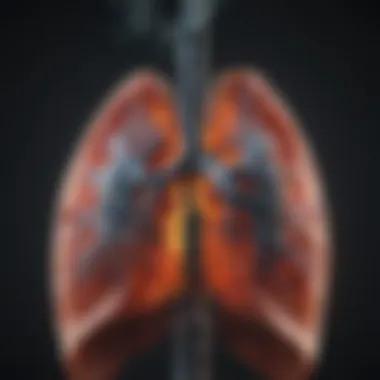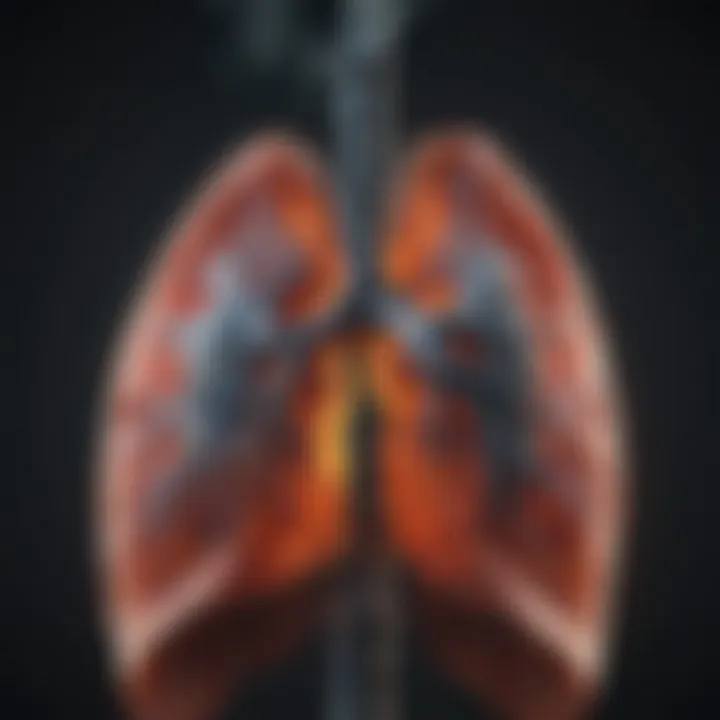Pathophysiology of Smoking: An In-Depth Overview


Intro
Smoking, often depicted as a mere habit, is a complex interplay of physiological mechanics that impose severe repercussions on human health. It’s not just the act of inhaling smoke; it’s an intricate amalgamation of biological interactions that lead to pathophysiological shifts across various organ systems. Grasping this complexity is crucial not only for health professionals but also for those keen on understanding the broader implications of tobacco use.
In the following sections, we will explore the detailed mechanisms at play when cigarettes or other tobacco products are consumed. This exploration aims to shed light on how smoking disrupts cellular functions, instigates disease progression, and ultimately hampers bodily systems. By weaving in contemporary research findings, the discussion underscores the pressing need for heightened awareness and effective prevention strategies against smoking-related ailments.
Let’s dive deeper into the research landscape that underpins our understanding of smoking's repercussions on health.
Preface to Smoking and Health
Understanding the health impacts of smoking is crucial in contemporary discussions about public health. Smoking is not merely a personal choice; it has far-reaching effects that touch on societal, environmental, and individual health. This section aims to highlight the significance of smoking and its rippling consequences across various fronts. By breaking down the elements surrounding tobacco use, we can begin to unravel the intricate relationship between smoking behaviors and health outcomes.
The importance of exploring smoking and health lies in several key factors:
- Epidemiological Insights: A deep dive into smoking-related morbidity and mortality helps illuminate its role in public health crises worldwide.
- Understanding Addiction: Recognizing tobacco's addictive properties lays the groundwork for better cessation strategies.
- Societal Burden: The economic costs associated with smoking—both direct healthcare expenditures and indirect losses from productivity—are staggering.
In short, focusing on smoking and health equips us with the knowledge needed to advocate for effective interventions and support systems. With a better grasp of these issues, researchers and policymakers can face the smoking epidemic head-on.
Historical Context of Tobacco Use
The journey of tobacco is steeped in history, stretching back centuries. Initially used for religious and medicinal purposes among Indigenous peoples of the Americas, it was later adopted by Europeans, leading to a surge in cultivation and trade.
- Early Use: Tobacco was often perceived as a cure for various ailments. It became a staple in the early colonies, ultimately shaping economies and the social fabric of nations.
- 19th Century Boom: With the advent of industrialization, cigarette production ramped up, making tobacco more accessible than ever. Advertisements glamorized smoking, portraying it as a symbol of luxury and sophistication.
- Health Awareness: The 20th century witnessed a slow shift in perception as mounting evidence emerged linking tobacco to serious health issues. The infamous 1964 report by the Surgeon General marked a turning point in public consciousness about smoking dangers.
The ongoing narrative of tobacco usage reflects shifting cultural attitudes, providing a context for understanding current statistics and health implications.
Current Statistics on Smoking Prevalence
Gaining insight into the present landscape of smoking can’t be overlooked in assessing its public health impact. The most recent statistics reveal a complex reality:
- Global Smoking Rates: Approximately 1.3 billion people worldwide smoke, showcasing significant variations across countries and demographics. In many developed nations, smoking rates have shown a decline, but in developing regions, the figures remain troublingly high.
- Demographic Factors: Certain populations are statistically more prone to smoking. Notably, disparities based on socioeconomic status, education level, and geographical regions often dictate smoking prevalence. These figures expose the unequal health burdens faced by different communities.
"Smoking is not just a habit; it’s a societal issue entwined with cultural, economic, and psychological threads."
- Youth Smoking Rates: Alarmingly, rates among younger individuals reveal patterns of rising use, particularly in the form of vaping.
Understanding these statistics is fundamental not just for research but also for crafting targeted public health campaigns. Awareness of the current state of smoking helps to mobilize efforts toward prevention and cessation, aiming for a healthier future.
Chemical Components of Cigarette Smoke
The chemical components of cigarette smoke are pivotal in understanding the pathological effects associated with smoking. It's not just about the act itself; the intricate mix of toxins, carcinogens, and additives present in tobacco products plays a substantial role in the adverse health outcomes we witness today. One might think of smoke as merely vapor, but within each puff lies a cocktail of substances that directly affect both our immediate wellbeing and long-term health.
Identification of Harmful Chemicals
Cigarette smoke contains over 7,000 chemicals, many of which are harmful. Of particular interest are tar, carbon monoxide, formaldehyde, and benzene. Each of these substances plays a unique role in the wider smoking pathology. Tar, for example, is a sticky residue that can coat the lungs, leading to a plethora of respiratory problems over time. Carbon monoxide, produced when smoking, binds to hemoglobin more effectively than oxygen, reducing the overall oxygen supply to organs and tissues, creating an environment ripe for disease.
Other compounds like ammonia and hydrogen cyanide are also of concern. Ammonia acts as an irritant, exacerbating respiratory symptoms, while hydrogen cyanide, often associated with insecticides, contributes to the neurotoxic effects of smoking. Recognizing the presence and impact of these harmful chemicals is crucial in understanding why smoking remains a significant public health threat.
Role of Nicotine in Addiction
Nicotine is often at the forefront of discussions surrounding smoking due to its addictive properties. It is a powerful stimulant that affects the central nervous system, amplifying the release of neurotransmitters like dopamine, which fuels feelings of pleasure and reward. This biochemical reaction explains why many individuals find it nearly impossible to quit once they have started smoking.
Moreover, nicotine's effects on the body extend beyond just addiction. It accelerates heart rate, increases blood pressure, and stimulates the release of adrenaline. While these might seem benign in a short-term context, the long-term cardiovascular implications can be detrimental. Understanding nicotine's dual role as both a driver of addiction and a modulator of physiological processes underscores its significance in the overall landscape of smoking-related health issues.
"The battle against smoking is not just a war on cigarettes; it's a deep understanding of what they deliver and the havoc they wreak on the body."
In summary, the examination of the chemical components of cigarette smoke reveals a complex interplay of toxins that lead to significant physiological changes in the body. Being cognizant of the harmful constituents and the specific role of nicotine is essential in grasping the broader implications of smoking for health and society. The detailed analysis of these elements guides the way toward effective prevention strategies and underscores the need for continuous research into smoking's pathophysiology.
Mechanisms of Smoking-Induced Tissue Damage
Understanding the various ways that smoking inflicts harm on tissues is fundamental for grasping the broader effects of tobacco use on health. The mechanisms behind smoking-induced tissue damage are multifaceted, encompassing oxidative stress, alterations in cellular signaling, and inflammatory responses. Each of these pathways contributes to the deteriorating state of health in smokers, emphasizing why it's crucial to address smoking from a biological perspective. This segment aims to illuminate those mechanisms, shedding light on how they interconnect and their overall significance in the development of smoking-related diseases.
Oxidative Stress and Free Radicals
When cigarettes are lit, they release thousands of toxic compounds. These compounds include free radicals, which are unstable molecules that can inflict cellular damage. Free radicals wreak havoc by stealing electrons from nearby molecules, leading to a cascade of oxidative damage. This oxidative stress is characterized by an imbalance between free radicals and antioxidants in the body. While antioxidants help neutralize free radicals, smoking overwhelms these protective mechanisms. As a result, peroxidation of lipids, DNA damage, and protein alterations can occur, disrupting normal cellular functions. This damage plays a key role in the development of chronic diseases while accelerating the aging process of tissues.


"Oxidative stress from smoking can alter cell DNA, leading to mutations that drive cancer development."
Key Facts about Oxidative Stress:
- Smoking raises oxidative stress levels significantly, increasing disease risk.
- It contributes to the pathogenesis of chronic obstructive pulmonary disease (COPD) and cancer.
- Smokers often exhibit lower levels of antioxidants in their body, decreasing cellular defense.
Alterations in Cellular Signaling Pathways
Cellular signaling pathways are networks of proteins that communicate and regulate various cellular functions. Smoking affects these pathways, particularly those involved in cell survival, proliferation, and apoptosis (programmed cell death). The disruption of signaling pathways leads to abnormal cellular behavior. For example, cigarette smoke can activate the nuclear factor kappa B (NF-kB), which promotes inflammatory responses and cell survival, allowing damaged cells to persist rather than undergo death. This contributes to tumor development since damaged cells are more likely to proliferate uncontrollably. On another note, altered signaling may impair immune responses, leaving the body vulnerable to infections.
Inflammatory Responses to Smoking
Chronic inflammation is another significant outcome of smoking. Tobacco smoke triggers an inflammatory response as the body attempts to counteract harmful substances. The immune system responds by increasing the production of inflammatory cytokines and immune cells, which can lead to sustained inflammation. Continuous exposure to smoke keeps inflammation active, resulting in tissue damage over time.
Consequences of Smoking-Induced Inflammation:
- It can lead to the destruction of lung tissue, a hallmark of chronic obstructive pulmonary disease.
- Inflammatory processes can foster an environment that enables cancer development.
- Ongoing inflammation can damage blood vessels, raising the risk of cardiovascular incidents.
Analyzing these mechanisms illustrates the shocking reality of smoking's impact on body systems. The interplay of oxidative stress, altered signaling pathways, and inflammation fundamentally alters the physiological landscape, making the risks very apparent for anyone willing to listen.
Impact on the Respiratory System
The respiratory system serves as a gateway for oxygen to enter our bodies and carbon dioxide to exit. However, when one takes up smoking, this essential function undergoes significant impairment. Understanding how smoking affects the respiratory system is critical because it lays the foundation for a myriad of health complications.
When cigarette smoke is inhaled, it introduces a cocktail of harmful substances into the lungs. Carcinogens, toxins, and particulate matter can inflict considerable harm, leading to chronic diseases. The consequences are not just limited to lung health; they ripple through other bodily systems.
Chronic Obstructive Pulmonary Disease
Chronic Obstructive Pulmonary Disease, commonly known as COPD, is a group of lung diseases that block airflow and make breathing difficult. This condition is chiefly caused by smoking, which damages the airways and the air sacs in your lungs. Patients may experience symptoms ranging from a persistent cough and shortness of breath to frequent respiratory infections.
- Emphysema: In this disease stage, the walls of the air sacs become damaged and lose their elasticity, trapping air in the lungs while compromising gas exchange. This can result in a feeling of breathlessness, making physical activities more strenuous.
- Chronic Bronchitis: This condition involves inflammation of the bronchi, leading to excessive mucus production and a chronic cough, further hindering airflow.
According to the World Health Organization, COPD is the third leading cause of death globally. This statistic shows just how vital it is to address smoking as a primary risk factor for this debilitating disease.
Lung Cancer Pathogenesis
The link between smoking and lung cancer is perhaps one of the most well-documented associations in medical research. The carcinogenic substances found in tobacco smoke can cause mutations in the lung cells. Over time, these mutations can accumulate, leading up to tumor formation.
Surprisingly, it is not just long-term smokers who are at risk; even those who smoke occasionally can suffer from increased risk. Factors that contribute to lung cancer include:
- Genetic predisposition: Certain individuals may be genetically more susceptible to the harmful effects of smoking.
- Duration and intensity: The length of time a person smokes matters greatly; the cumulative exposure increases cancer risk.
- Age: Older adults tend to face a higher risk, but young smokers can also find themselves in dangerous territory.
The alarming reality is that the majority of lung cancer cases are directly associated with smoking, underscoring the urgent need for smoking cessation programs and interventions.
Effects on Airway Function
Smoking detrimentally affects airway function, which can be observed through various physiological changes. The fine hairs lining the airways, known as cilia, become paralyzed by the toxins within cigarette smoke. This paralysis impairs the body’s ability to clear mucus and foreign particles from the lungs, making infections more likely.
Moreover, the smoke causes chronic inflammation of the airways, leading to:
- Increased airway resistance: This makes it more difficult for air to flow in and out of the lungs.
- Hyperreactivity of the airways: Such hyperreactivity can trigger asthma attacks and other respiratory issues even in people without pre-existing conditions.
The negative ramifications of these airway changes are far-reaching, as they not only compromise respiratory function but also influence overall health and quality of life.
"Understanding the impact of smoking on respiratory health helps in tailoring effective public health messages aimed at prevention and education."
As we navigate through the complications smoking poses to the respiratory system, it becomes abundantly clear that the fight against tobacco use is one that holds significance not just for individuals, but for society as a whole. Addressing these health risks is essential in paving the way for a healthier future.
Cardiovascular Implications
Understanding the cardiovascular implications of smoking is vital, considering the substantial burden of heart disease globally. Tobacco use impacts the cardiovascular system in significant, often irreversible ways. When we light up a cigarette, the chemicals released into the bloodstream wreak havoc on blood vessels and heart function. Recognition of this link precedes numerous health campaigns aimed at reducing smoking rates, making this topic both timely and crucial.
Smoking and Atherosclerosis Development
A fundamental way smoking contributes to heart disease is through the development of atherosclerosis. This condition is characterized by the accumulation of plaques within arteries, leading to reduced blood flow and oxygen delivery to vital organs. The process begins when smoking introduces high levels of toxic substances—like carbon monoxide and tar—into the body. These elements promote inflammation and damage the inner lining of blood vessels, altering their function.
This process can be succinctly broken down into several key stages:


- Inflammation: Smoking causes an inflammatory response that can significantly damage endothelial cells. These cells; they line the blood vessels and play a critical role in maintaining vascular health.
- Lipid Accumulation: Once inflammation occurs, there's an increase in oxidation of lipids in the blood. These oxidized low-density lipoproteins (LDL) become trapped in the artery walls, leading to further plaque development.
- Plaque Formation: Over time, these plaques cause narrowing of the arteries, which can eventually lead to complete blockage or rupture, resulting in severe cardiovascular events such as heart attacks or strokes.
Thus, every puff on a cigarette potentially accelerates atherosclerosis as the smoker's blood vessels face a persistent onslaught of detrimental effects, making it a silent adversary against cardiovascular health.
Increased Risk of Heart Disease
The correlation between smoking and an increased risk of heart disease is backed by substantial evidence in medical literature. Smokers are not just putting themselves at risk; they are also affecting the health of those around them through secondhand smoke. It’s a well-established fact that smoking raises the heart rate and blood pressure, complicating existing cardiovascular conditions or leading to new ones.
Consider the following points:
- Coronary Heart Disease (CHD): Smokers are two to four times more likely to develop CHD compared to non-smokers. This condition results from reduced blood flow to the heart.
- Heart Attack Incidence: Approximately one in five heart attacks is attributable to smoking, leading to significant morbidity and mortality.
- Recovery Complications: For individuals with heart disease, smoking complicates recovery, prolonging hospital stays and increasing the chances of recurrent events.
In essence, smoking doesn’t just increase the risk of heart disease; it fosters an environment where existing conditions can worsen, ultimately leading to life-threatening outcomes.
The evidence is clear: smoking is a leading risk factor for heart disease, responsible for approximately 20% of deaths from cardiovascular diseases.
Effects on the Immune System
Understanding how smoking impacts the immune system is crucial in comprehending the broader implications of tobacco use on health. The immune system serves as the body’s defense mechanism against pathogens, and any interference with its functionality can lead to increased susceptibility to infections, chronic inflammation, and even the development of various diseases. Furthermore, the alteration of immune responses due to smoking emphasizes the need for focused public health initiatives aimed at reducing smoking rates and enhancing awareness about its damaging effects on immunity.
Immunosuppressive Effects of Smoking
Cigarette smoke is a cocktail of harmful substances; this concoction includes over 7,000 chemicals, many of which exert immunosuppressive effects. The most notorious offenders are the polycyclic aromatic hydrocarbons and various heavy metals, which can inhibit immune responses and diminish the body’s ability to fend off infections. This muffles the immune surveillance system, leading to an alarming increase in opportunistic infections.
Additionally, studies indicate that smoking may alter the production of cytokines, the signaling molecules that mediate and regulate immunity, inflammation, and hematopoiesis.
For instance:
- Decreased T-cell proliferation: Smoking negatively impacts T-cell function, which is vital for adaptive immunity.
- Increased susceptibility to respiratory infections: The likelihood of developing respiratory infections, such as pneumonia and chronic bronchitis, is significantly heightened in smokers due to the impaired function of immune cells residing in the lungs.
According to research, the immunosuppressive nature of cigarette smoke is closely linked to the risk of developing autoimmune conditions, as the body may be unable to mount appropriate responses to its own tissues.
"The multifaceted nature of smoking leaves the immune system out to dry, rendering it ineffective when it matters most."
Alteration of Immune Cell Function
Beyond overall suppression, smoking leads to specific alterations in immune cell functionality. Notably, various types of immune cells, including macrophages, neutrophils, and B-cells, are profoundly affected. For example, macrophages, which are crucial in detecting and eliminating pathogens, become less effective in smokers. This impairment is largely attributed to the presence of free radicals in smoke, which can damage the cell membranes of these immune cells, hampering their ability to respond effectively to pathogens.
In addition, studies have demonstrated that smoking can cause:
- Altered dendritic cell function: Dendritic cells play a pivotal role in antigen presentation and the activation of T-cells. When functioning improperly, they may lead to ineffective immune responses.
- Imbalanced cytokine production: An altered cytokine profile, characterized by increased pro-inflammatory cytokines and decreased anti-inflammatory agents, fuels chronic inflammation, which can further complicate existing conditions and elevate the risk of chronic diseases.
Overall, the adverse effects of smoking on immune cell function underscore the urgent need for cessation efforts and research dedicated to understanding these complex interactions. By grasping the impact that smoking has on the immune system, we can better advocate for both preventative measures and treatment strategies to combat smoking-related health issues.
Pathophysiology of Smoking-Related Cancers
Understanding the pathophysiology of smoking-related cancers is a pivotal aspect of this analysis. Tobacco smoke provides a milieu replete with carcinogenic compounds, which intricately manipulate cellular processes that lead to malignancy. As we explore this topic, it becomes clear that comprehension of these mechanisms not only enhances our understanding but also lays the groundwork for effective prevention and intervention strategies.
Cancers associated with smoking are not merely incidental findings; they illustrate the grave consequences of chronic tobacco use. Highlighting the biological transformations induced by smoking helps in elucidating the steep increase in cancer rates among smokers compared to non-smokers. This section will meticulously dissect those molecular changes and illuminate specific cancers tied to tobacco consumption, offering crucial insights for students, researchers, educators, and healthcare professionals alike.
Molecular Changes Leading to Cancer
The journey from smoking to cancer is paved with various molecular changes that may seem arcane but are fundamentally important. One could liken it to a domino effect; once the initial molecular alterations occur, a cascade of events unfolds, ultimately resulting in cancer.
- DNA Damage: The primary mechanism at play begins with DNA adduct formation, where harmful chemicals in cigarette smoke bond with DNA, causing mutations. If these mutations occur in critical genes such as tumor suppressor genes or oncogenes, it could trigger tumorigenesis.
- Inflammation: Smoking induces a chronic inflammatory state, which is a breeding ground for cancer. The continuous release of pro-inflammatory cytokines creates a hostile environment that fosters tumor growth.
"Chronic inflammation due to smoking acts like a double-edged sword, facilitating cancer progression while simultaneously inhibiting effective immune responses."
- Immune Evasion: Cancer cells often develop mechanisms to evade immune surveillance. Smoking impairs the function of immune cells, making it easier for malignant cells to flourish unchecked.
- Epigenetic Modifications: Beyond genetic mutations, smoking also causes epigenetic changes that can silence tumor suppressor genes or activate oncogenes through processes such as methylation.
These molecular transformations are not isolated incidents but rather an intricate interplay of factors that create conditions ripe for the development of cancer.
Specific Types of Cancer Associated with Smoking
The scope of cancers linked to tobacco use is extensive. Each type has discernable characteristics and underlying biological mechanisms, detailing how cigarette smoke contributes to their pathogenesis.


- Lung Cancer: The most notorious cancer related to smoking, lung cancer results primarily from the inhalation of carcinogens found in tobacco smoke. It accounts for the largest proportion of cancer deaths globally.
- Head and Neck Cancers: Smoking plays a significant role in cancers of the oral cavity, throat, and larynx. The carcinogens in tobacco can cause cellular changes in these sensitive tissues, leading to malignancies that often present late due to their stealthy nature.
- Esophageal Cancer: Tobacco use elevates the risk of esophageal squamous cell carcinoma. The direct contact of smoke compounds with the esophagus sets the stage for cellular transformation.
- Bladder Cancer: Smokers are at a heightened risk for bladder cancer. Carcinogenic byproducts of tobacco are excreted in urine, exposing the bladder lining to harmful agents regularly.
- Pancreatic Cancer: There’s a robust correlation between smoking and increased incidence of pancreatic cancer, distinguished by its poor prognosis and late presentation.
Each of these cancers carries a unique pathophysiological profile shaped by the toxic exposure from smoking. Charting the link between tobacco use and cancer incidence offers substantial implications for public health policies and interventions designed to curb smoking rates.
In summary, understanding how smoking instigates and propels these cancers is crucial in a comprehensive examination of its pathophysiology. Teaching society about these mechanisms could serve as a wake-up call, inciting more robust prevention strategies and ultimately saving lives.
Socioeconomic Impact of Smoking
The socioeconomic impact of smoking is a significant aspect of tobacco use that can’t be overlooked. It's not just a matter of personal health; it ripples through communities, economies, and healthcare systems. Understanding this impact can help create more effective strategies for addressing smoking-related issues at various levels. From increased healthcare costs to loss of productivity, the aftermath of smoking extends well beyond individual smokers.
Financial Costs of Tobacco Use
The financial burden imposed by smoking is staggering. Direct expenditures by individuals on cigarettes, coupled with indirect costs such as healthcare expenses and lost productivity, paint a grim picture. Consider a smoker who spends an average of $7 per pack. If they smoke a pack a day, that's nearly $2,555 a year. Let's not forget that these costs add up over time.
In a broader context, here’s what the financial impact looks like:
- Direct Costs: This includes the price of tobacco products, which often escalate with taxes aimed at discouraging smoking.
- Indirect Costs: These encompass loss of income due to smoking-related illnesses, accounting for a significant portion of economic loss.
- Healthcare Costs: Smokers often face higher medical expenses and longer hospital stays due to smoking-related diseases. The CDC estimates that smoking-related illness in the United States costs more than $300 billion each year, including nearly $170 billion for direct medical care.
Impact on Healthcare Systems
The effect of smoking on healthcare systems is nothing short of overwhelming. A large segment of healthcare resources are consumed by smoking-related illnesses. This not only strains resources but also reduces the quality of care available to others. Healthcare professionals often find themselves contending with an influx of patients suffering from chronic conditions such as lung cancer and emphysema. The economic strain can be summed up in a few key points:
- Increased Hospital Admissions: Smokers typically require more frequent medical treatment, leading to increased admissions, especially in emergency rooms.
- Longer Recovery Times: Smoking complications can lead to longer hospital stays, which stretches the capacity of healthcare facilities.
- Preventive Healthcare Costs: Health systems must invest significantly in chronic disease management and preventive programs to address smoking-related health issues.
"The costs associated with smoking go beyond the individual; they affect families, communities, and national economies."
By focusing on the socioeconomic facets of smoking, stakeholders can better understand the broader implications. Smoker’s decisions don’t just impact their lives but reverberate through societal structures. In this regard, it becomes crucial to incorporate this understanding into public health strategies. Successful interventions often hinge on not just addressing tobacco use at an individual level, but evaluating and reforming the systems that surround it in order to foster healthier communities.
Prevention and Intervention Strategies
In the quest to understand the multifaceted issues related to smoking, prevention and intervention strategies stand out as crucial elements. Tackling smoking involves not just acknowledging the problem but also implementing comprehensive plans to mitigate its impact. This section will delve into the intricate layers involved in these strategies, emphasizing their benefits and considerations to foster a healthier society.
Public Health Campaigns
Public health campaigns play a vital role in combating smoking by spreading awareness and educating the masses about its dangers. Through various platforms, including social media, television, and community events, these campaigns strive to reach a broad audience. The objective is clear: inform individuals about the adverse effects of smoking on health, finances, and overall quality of life.
The effectiveness of such campaigns can be understood through several key components:
- Targeted Messaging: Campaigns that tailor their messages to specific demographic groups tend to resonate more effectively. For instance, adolescents may respond better to creative visuals and relatable narratives, while older populations might appreciate factual data and statistics about long-term health risks.
- Visibility and Accessibility: The locations where these campaigns are executed also matter. Whether it's through billboards in urban areas or pamphlets in clinics, the more accessible the information is to the public, the better the chances of influencing behavior.
- Engagement Techniques: Utilizing interactive platforms, such as online quizzes or testimonial videos, can actively engage individuals. By encouraging participation, campaigns increase the likelihood of individuals understanding the inherent risks associated with smoking.
"Prevention is better than cure; it's a wise old saying that rings true in tackling smoking."
Implementing public health campaigns not only aids in decreasing smoking rates but it also fosters an environment where healthy choices can thrive, reinforcing the idea that a smoke-free lifestyle is not just encouraged, but celebrated.
Role of Education in Smoking Prevention
Education serves as the cornerstone of any successful tobacco control initiative. By incorporating smoking prevention programs into school curricula and community workshops, individuals are equipped with the knowledge to make informed decisions. Understanding the physiological and societal implications of smoking can have lasting effects on behavior.
Key aspects encompass:
- Curriculum Development: Educational institutions must prioritize comprehensive smoking prevention education, integrating lessons about the dangers of smoking as well as practical skills for resisting peer pressure.
- Community Involvement: Schools should collaborate with local organizations to promote community-wide initiatives, where parents and children can participate in workshops designed to teach both parties about the risks associated with smoking.
- Long-term Health Literacy: Building awareness about smoking goes beyond just teaching the immediate risks. It involves fostering a broader understanding of overall health and wellness, making individuals more likely to prioritize their health throughout their lives.
Additionally, instilling critical thinking skills in students can empower them to analyze marketing tactics often used by tobacco companies, hence enhancing their resistance to smoking down the line.
The fight against smoking is not just a battle within ourselves but also a collective movement that requires concerted efforts at different societal levels. By implementing effective public health campaigns and focusing on education, the landscape of smoking in our communities can be transformed for the better.
Future Directions in Smoking Research
The topic of future directions in smoking research is essential as it not only underscores the evolving understanding of smoking's impacts on health but also emphasizes the need for innovation in combating tobacco use. Addressing tobacco addiction is a multi-faceted challenge that intertwines scientific, social, and economic factors. With ongoing advancements, various dimensions of this issue beckon further inquiry and practical solution development.
Innovations in Smoking Cessation Techniques
Recent years have seen substantial progress in techniques aimed at smoking cessation. Novel methods go beyond traditional approaches, such as nicotine replacement therapies. These innovations are critical because they target the diverse aspects of nicotine addiction, tackling physical dependence as well as behavioral components.
- Digital health interventions: The rise of mobile applications and online platforms for cessation support provides users with on-demand resources tailored to their specific needs. Evidence shows that these tools can enhance the likelihood of quitting by maintaining user engagement through tailored messaging and support.
- Pharmacological advancements: Researchers continue to explore new pharmacotherapies aimed at reducing cravings and withdrawal symptoms. For instance, medications that influence neurotransmitter systems might play a role in lessening the overall impact nicotine has on the brain, thus fostering a more manageable withdrawal process.
- Behavioral therapy integration: Hybrid approaches that combine behavioral therapy with pharmacological support have shown promising results. These therapies seek to modify the behaviors and thought patterns that contribute to smoking, allowing individuals to devise effective coping strategies.
"Innovative cessation techniques not only focus on reducing dependence but also consider the psychological dimensions of smoking addiction, making them more effective for a broader audience."
Advancements in Understanding Tobacco Addiction
Continuing research into tobacco addiction has illuminated the complexities surrounding this behavior. Understanding these intricacies is vital for forming effective interventions and policies. Several key areas warrant attention:
- Neuroscientific insights: Recent studies examine how nicotine alters brain circuits associated with reward and stress. By delineating the pathways affected by smoking, researchers aim to identify potential targets for new treatments.
- Longitudinal studies: Tracking smoking behaviors over time allows researchers to identify triggers and patterns that lead to addiction. These findings can guide the development of personalized cessation plans that address individual needs and contexts.
- Socioeconomic factors: Acknowledging that socioeconomic status heavily influences smoking habits and cessation success is crucial. Research in this area explores how interventions can be tailored to support individuals in varying social and economic circumstances, thereby making cessation resources more equitable.



